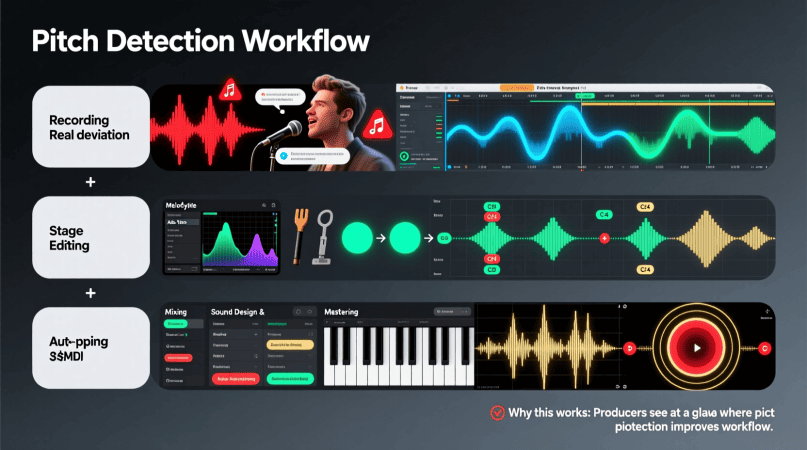
Pitch detection isn’t just a tool for correcting mistakes—it’s one of the foundations of modern music production.
Whether you’re recording vocals, fine-tuning instruments, or experimenting with creative effects, understanding how pitch detection works can transform the way you produce music.
Try Our: note to frequency converter
Quick Answer
Pitch detection helps producers and engineers by:
- Improving vocal accuracy through real-time monitoring and post-production tuning
- Aligning tracks like vocal doubles or harmonies for cleaner mixes
- Transforming sound design with formant shifts, harmonizers, and robotic effects
- Converting audio to MIDI, opening creative possibilities across instruments
What Is Pitch Detection?
At its core, pitch detection is the process of identifying the exact frequency of a note in real time. Unlike pitch correction (which changes the note to match a scale or key), detection is about measurement and analysis. Once detected, that pitch can be monitored, adjusted, or even re-purposed creatively.
| Feature | Pitch Detection | Pitch Correction |
|---|---|---|
| Function | Identifies pitch frequencies | Adjusts pitch to a target note |
| Role in Production | Analysis, monitoring, creative | Fixing inaccuracies |
| Creative Potential | Harmonics, audio-to-MIDI | Robotic or natural vocal tuning |
Try Our: note detection from recordings
Real-World Uses in Music Production
1. Vocal Tuning and Performance Feedback
Producers often use pitch detection in recording sessions to give singers real-time feedback. Instead of waiting for post-production, artists can see or hear where their pitch drifts, helping them deliver stronger takes.
2. Mixing and Layering
Pitch detection is key when aligning vocal doubles or harmonies. Even slight deviations in pitch can muddy a mix. By detecting and adjusting, engineers create a polished, cohesive vocal stack.
3. Creative Sound Design
Pitch detection goes beyond accuracy—it unlocks experimental effects:
- Generating harmonies from a single voice
- Formant shifting to change the timbre of vocals without altering pitch
- Using audio-to-MIDI conversion, turning a guitar riff into a synth line
These creative applications make pitch detection one of the most versatile tools in modern studios.
4. Live Music Applications
For performers, pitch detection helps with on-stage monitoring and auto-tune effects. Artists can use it to ensure consistent delivery during live shows or add stylistic pitch-based effects in real time.
FAQs About Pitch Detection
1. Why is pitch detection important in music production?
Because it ensures accuracy, improves workflow, and allows creative control over sound design.
2. Can pitch detection be used without correction?
Yes. Many engineers use it purely for monitoring and analysis, especially in recording sessions.
3. Is pitch detection only for vocals?
No. It works on instruments too, from guitar and bass to horns and strings.
4. How does audio-to-MIDI rely on pitch detection?
The software detects note frequencies and converts them into MIDI data, enabling instrument replacement or layering.
5. Does pitch detection improve mastering?
Indirectly. While it’s not part of mastering itself, earlier pitch accuracy ensures mixes translate better in mastering.
Final Thoughts
Pitch detection is more than a behind-the-scenes process—it’s a creative ally. It empowers singers to perform confidently, helps engineers polish mixes, and gives producers tools to reshape sound in ways that weren’t possible a generation ago.
If you’re serious about music production, learning how to integrate pitch detection into your workflow can take your projects from good to professional.
Pitch Detector is a project by Ornella, blending audio engineering and web technology to deliver precise, real-time pitch detection through your browser. Designed for musicians, producers, and learners who want fast, accurate tuning without installing any software.
